Intel Core i3-4340, Core i3-4330 and Core i3-4130 Review

A lot of CPUs for LGA 1150 platform are available now. You can buy not only quad-core Core i7 and Core i5 but also less expensive dual-core Core i3-4340, Core i3-4330 or Core i3-4130. In our next review we have tested these models based on contemporary Intel Haswell microarchitecture.
The recently released processors of the Haswell generation are a step forward in the development of Intel’s CPU designs, yet we are not very enthusiastic about them. The Haswell is optimized for energy-efficient products and offers higher graphics performance, both factors being most important for mobile gadgets. But when it comes to desktop PCs, the new LGA1150 platform doesn’t provide great performance benefits over the older LGA1155 with Sandy Bridge and Ivy Bridge CPUs. The mobile orientation of the Haswell design and Intel’s somewhat negligent attitude towards the steadily shrinking community of desktop PC users explain the downsides we find in the desktop Haswell-based CPUs such as their enormous power consumption at high computing loads and, as a consequence, high operating temperatures.
The desktop Haswell is represented by a number of different CPU models, though. So besides the rather disappointing quad-core modifications, there may be interesting offers in other market segments. Intel manufactures eight variants of the Haswell die, differing in the number of x86 cores and in the integrated graphics core configuration. That’s why we want to continue our exploration of this CPU family.
Today we will be talking about the dual-core Haswell-based CPUs belonging to the Core i3 series. Released this fall, they seem to bring about more innovations than their quad-core counterparts. They don’t just offer a new microarchitecture with old specs. Feeling some pressure from AMD’s APUs, Intel decided to increase the amount of cache memory and added support for vector and cryptographic instructions. The integrated graphics has changed, too. Intel used to embed its GT2 core into select dual-core CPU models, but now it is available in every Haswell-based Core i3. The APU concept seems to be taken up by Intel now, so the company equips its inexpensive CPUs with a rather fast graphics core, following the current market trends.
As a result, the new Core i3 processors are more attractive than their predecessors in many ways. But is it enough to make users switch from their old LGA1155 configurations to modern LGA1150 platforms? We’ll try to answer this question in this review.
It must be noted that the LGA1150 platform has come to the market for a very long time. Desktop CPUs develop at a slower rate now and we are not at all sure that the Haswell Refresh initiative planned by Intel for the end of the next year will affect the Core i3 series. It looks like users of inexpensive desktop PCs will have to install a Haswell sooner or later.
4th Generation Intel Core i3 in Detail
With the release of the 32nm Sandy Bridge processors, Intel introduced a clear and consistent nomenclature of its CPU families. The Core i5 and Core i7 series included chips with four cores or more while the Core i3 series only consisted of dual-core products. These dual-core CPUs support Hyper-Threading, so the OS identifies them as quad-core ones. The i3 series lacked the auto-overclock feature Turbo Boost and didn’t support the AES cryptographic instructions.
The Core i3 specifications didn’t change much after its transition from the Sandy Bridge to the 22nm Ivy Bridge design. Its key features remained intact; the clock rates and the L2 cache didn’t grow up much. We had expected the same lack of progress in the 22nm Haswell-based Core i3 products but Intel has come up with a few surprises. The basics are the same: the new Core i3 CPUs have two cores and support Hyper-Threading. Their clock rates haven’t changed much, either, but the amount of L3 cache memory is 4 instead of 3 megabytes now. Any instruction-related limitations have been removed altogether, so they support the AES and AVX2 instruction sets.
Thus, Intel’s dual-core Haswell-based CPUs for the LGA1150 platform have got closer to the Core i5 series, even though Hyper-Threading cannot really make up for two physical computing cores. The Core i3 products are much more affordable. The senior dual-core Haswell-based model is more than $30 cheaper than the junior quad-core processor with the same microarchitecture. This might be expected as the 22nm semiconductor die employed in the newest Core i3 chips is much smaller than the full-featured Haswell die: 130 vs. 177 sq. mm.
Now let’s take a closer look at the three models the Haswell-based Core i3 series currently consists of: Core i3-4340, Core i3-4330 and Core i3-4130.
The Core i3-4340 is the senior dual-core Haswell model. Working at 3.6 GHz, it is a mere 100 MHz faster than the senior Core i3 model of the Ivy Bridge generation. So the performance growth ensured by the i3-4340 is largely due to the improvements brought about by the Haswell microarchitecture. We know it amounts to 5 or 10% but the mentioned 33% increase in the amount of L3 cache must be taken into account, too. The larger cache has higher associativity, though. It used to be 12-way but now is 16-way associative, which means that it has become more efficient in terms of data hits but has higher read latencies. So, the positive effect of the larger cache is not obvious.
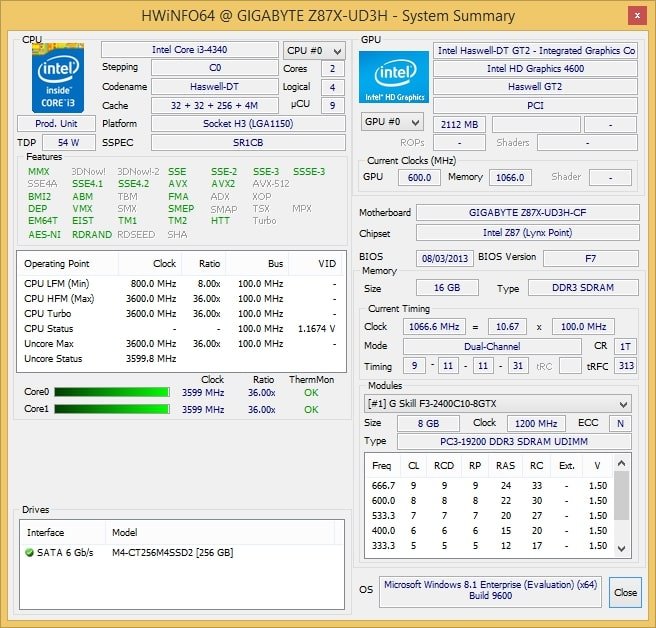
What is undoubtedly a positive improvement, the new CPU supports not only the new 256-bit vector instructions AVX2/FMA3 but also the AES-NI instructions which used to be blocked in the earlier Core i3 CPUs for marketing reasons.
Then, the new Core i3 series, including the i3-4340 model, features Intel’s 7th generation integrated graphics core GT2 with 20 execution devices. Like in the Haswell-based Core i5 and Core i7, this HD Graphics 4600 core is rather fast at 1150 MHz and supports Intel Quick Sync. We can remind you that GT2-class graphics was only implemented in specific dual-core Ivy Bridge products, namely in the Core i3-3225 and Core i3-3245.
The i3-4340 has a TDP of 54 watts, which is 1 watt less than the TDP of the previous Core i3 processors. In other words, Intel suggests that the transition of the dual-core CPUs to the Haswell microarchitecture doesn’t lead to an increase in their heat dissipation and power consumption as is the case with the quad-core CPUs.
The Core i3-4330 is a less advanced version of the Core i3-4340 which has the same capabilities. The two products are comparably priced, differing by a mere $10. That’s the price of the 100MHz difference in clock rate which is set at 3.5 GHz for the i3-4330 (the same as the clock rate of the senior dual-core Ivy Bridge model, Core i3-3250).
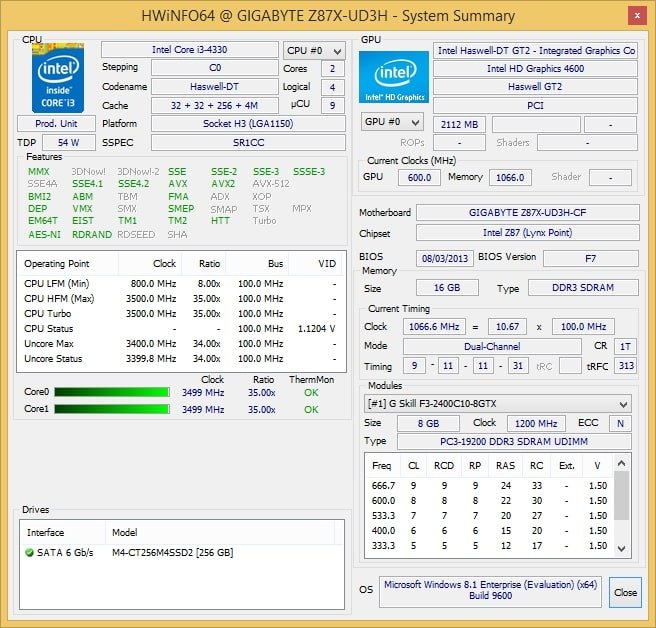
The rest of the specs of the Core i3-4340 and Core i3-4330 are identical. We mean the 4MB L3 cache, instruction sets, and 1150MHz HD Graphics 4600.
The Core i3-4130 is different from its cousins, even though it is a dual-core Haswell, too. The difference is reflected in its model name even. The number 4130 suggests that it is inferior to the i3-4340 and i3-4330 in more respects than just its clock rate, which is 3.4 GHz. It has only 3 megabytes of L3 cache, just like the Core i3 for the LGA1155 platform.
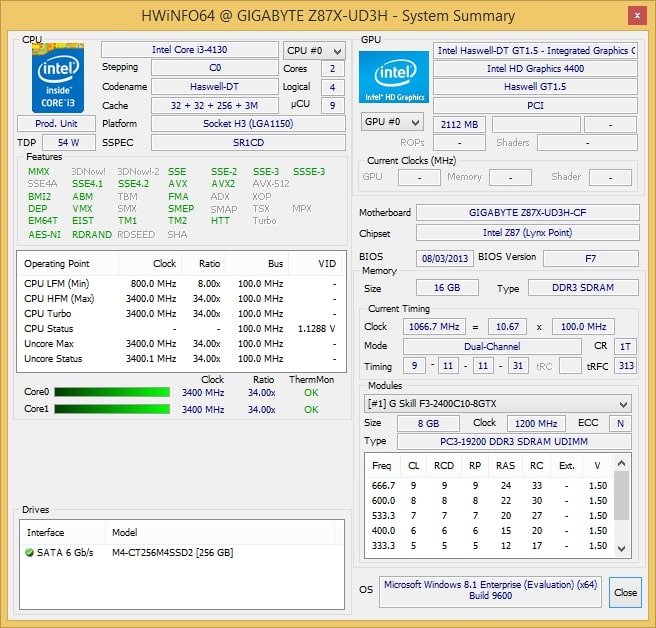
The Core i3-4130 is substantially cheaper than its senior cousins because the reduced amount of cache is not the only difference. Although it does support Hyper-Threading, vector and cryptographic instructions and other Core i3 features, it has a less advanced graphics core. The latter formally belongs to the GT2 class too, but it is called Intel HD Graphics 4400 and has lower performance with only 16 execution devices. It has the same clock rate of 1150 MHz as in the other new CPUs and supports Intel Quick Sync.
The smaller L3 cache and the simpler integrated graphics don’t affect the TDP of the i3-4130. Like the other new Core i3 processors, it has a TDP of 54 watts.
The following table sums up the specs of the Haswell-based Core i3 products:
Winding up the descriptive part of this review, we want to remind you that the LGA1150 Core i3 processors, just like their predecessors, are not meant for enthusiasts. They have a locked frequency multiplier and cannot be overclocked. You can overclock system memory and their integrated graphics core, though.
Testbed and Methods
We’ll test the 22nm Haswell-based Core i3 series today. It includes three CPU models (Core i3-4340, Core i3-4330 and Core i3-4130) and we’ve got all of them. We will pit them against the Core i3 3000 series, taking its senior and midrange models. Besides that, we will take junior quad-core i5 series CPUs to see how the new Core i3 products compare with their higher-class cousins.
There will also be some AMD products. Considering the current prices, the dual-core i3 series can be compared with AMD’s FX CPUs that have 4, 6 and even 8 cores. That’s why you’ll see three variants of the Socket AM3+ platform in the diagrams. We’ll also include the Socket FM2 platform, represented by the top-end Richland-based model A10-6800K.
Here is the full list of the hardware and software components we’re going to use for this test session.
- Processors:
- AMD A10-6800K (Richland, 4 cores, 4.1-4.4 GHz, 2×2 MB L2)
- AMD FX-8350 (Vishera, 8 cores, 4.0-4.2 GHz, 4×2 MB L2, 8 MB L3)
- AMD FX-6350 (Vishera, 6 cores, 3.9-4.2 GHz, 3×2 MB L2, 6 MB L3)
- AMD FX-4350 (Vishera, 4 cores, 4.2-4.3 GHz, 2×2 MB L2, 4 MB L3)
- Intel Core i5-4430 (Haswell, 4 cores, 3.0-3.2 GHz, 4×256 KB L2, 6 MB L3)
- Intel Core i5-3330 (Ivy Bridge, 4 cores, 3.0-3.2 GHz, 4×256 KB L2, 6 MB L3)
- Intel Core i3-4340 (Haswell, 2 cores + HT, 3.6 GHz, 2×256 KB L2, 4 MB L3)
- Intel Core i3-4330 (Haswell, 2 cores + HT, 3.5 GHz, 2×256 KB L2, 4 MB L3)
- Intel Core i3-4130 (Haswell, 2 cores + HT, 3.4 GHz, 2×256 KB L2, 3 MB L3)
- Intel Core i3-3250 (Ivy Bridge, 2 cores + HT, 3.5 GHz, 2×256 KB L2, 3 MB L3)
- Intel Core i3-3225 (Ivy Bridge, 2 cores + HT, 3.2 GHz, 2×256 KB L2, 3 MB L3)
- CPU cooler: NZXT Havik 140
- Mainboards:
- ASUS M5A99FX PRO R2.0 (Socket AM3+, AMD 990FX + SB950)
- ASUS F2A85-V Pro (Socket FM2, AMD A85)
- ASUS P8Z77-V Deluxe (LGA 1155, Intel Z77 Express)
- Gigabyte Z87X-UD3H (LGA 1150, Intel Z87 Express)
- System memory: 2 x 8 GB DDR3-2133 SDRAM, 9-11-11-31 (G.Skill [TridentX] F3-2133C9D-16GTX)
- Graphics card: Nvidia GeForce GTX 780 (3 GB/384-bit GDDR5, 863-902/6008 MHz)
- Disk subsystem: Intel SSD 520 240 GB (SSDSC2CW240A3K5)
- Power supply: Corsair AX760i (80 Plus Platinum, 760 W)
- Operating system: Microsoft Windows 8 Enterprise x64
- Drivers:
- AMD Chipset Drivers 13.9
- AMD Catalyst 13.9 Driver
- Intel Chipset Driver 9.4.0.1027
- Intel HD Graphics Driver 15.33.5.64.3316
- Intel Management Engine Driver 9.0.2.1345
- Intel Rapid Storage Technology 12.8.0.1016
- NVIDIA GeForce 331.65 Driver
The main part of this testing was carried out with a discrete graphics card Nvidia GeForce GTX 780, so we didn’t focus on benchmarking the graphics core integrated into Intel’s new CPUs. However, we’ve got a special report on modern integrated graphics where you can find performance data about the HD Graphics 4600 solution available in the Haswell-based Core i3 CPUs.
Performance Tests
General Performance
As usual, we use the Bapco SYSmark 2012 suite to estimate performance in general-purpose tasks. It emulates a user working in popular office and digital content creation and processing applications. The idea behind this test is fairly simple: it produces a single score indicative of the computer’s average performance across different applications. After the launch of Windows 8, SYSmark 2012 got updated to version 1.5, so we use that adapted version for our tests.
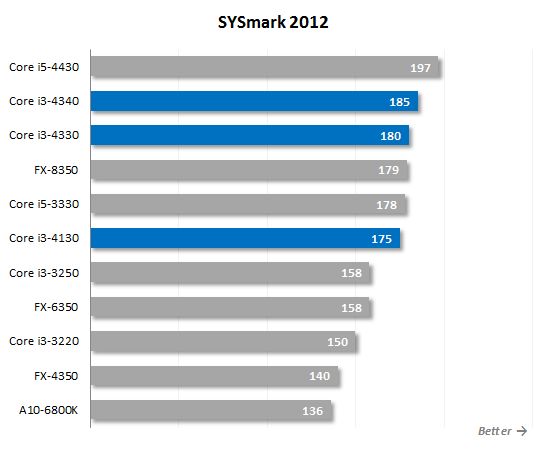
The new Haswell-based Core i3 CPUs are considerably faster than their Ivy Bridge predecessors. The i3-4340 is 17% ahead of the i3-3250, which is more than the performance gap between the quad-core CPUs of the Haswell and Ivy Bridge designs. SYSmark 2012 doesn’t seem to notice the larger cache of the new i3-4340 and i3-4330, though. The i3-4130 with its 3MB L3 cache is a mere 3% behind the i3-4330 with 4MB L3 cache – this may easily be due to the 100MHz difference in their clock rates.
The progressive architecture of the new CPUs is confirmed by one more fact. The senior Haswell-based Core i3 CPUs are on average faster than the junior Ivy Bridge Core i5. Thus, the newest breed of Core i3 processors seem to be perfect for midrange computers. They offer the best price/performance ratio at everyday loads, at least according to SYSmark 2012.
Now let’s take a closer look at the performance scores SYSmark 2012 generates in different usage scenarios. The Office Productivity scenario emulates typical office tasks, such as text editing, spreadsheets, email and web-surfing. This scenario uses the following applications: ABBYY FineReader Pro 10.0, Adobe Acrobat Pro 9, Adobe Flash Player 10.1, Microsoft Excel 2010, Microsoft Internet Explorer 10, Microsoft Outlook 2010, Microsoft PowerPoint 2010, Microsoft Word 2010 and WinZip Pro 14.5.
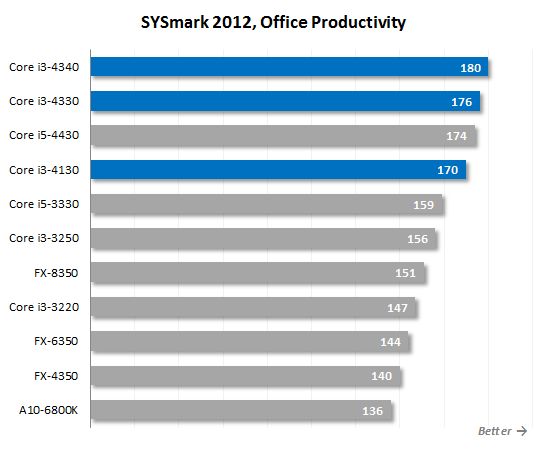
The Media Creation scenario emulates the creation of a video clip out of prepared materials (digital images and videos) using popular tools from Adobe: Photoshop CS5 Extended, Premiere Pro CS5 and After Effects CS5.
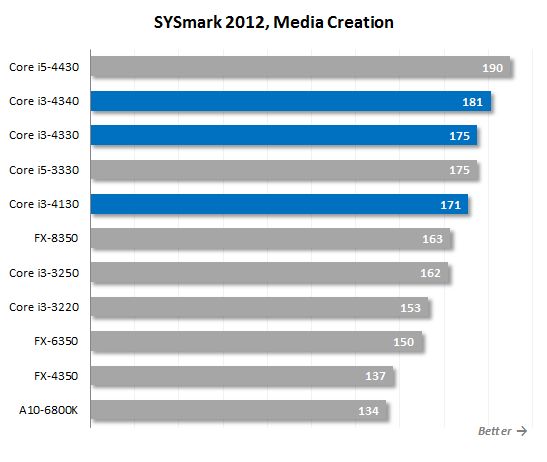
Web Development is a scenario emulating website authoring. It uses the following applications: Adobe Photoshop CS5 Extended, Adobe Premiere Pro CS5, Adobe Dreamweaver CS5, Mozilla Firefox 3.6.8 and Microsoft Internet Explorer 10.
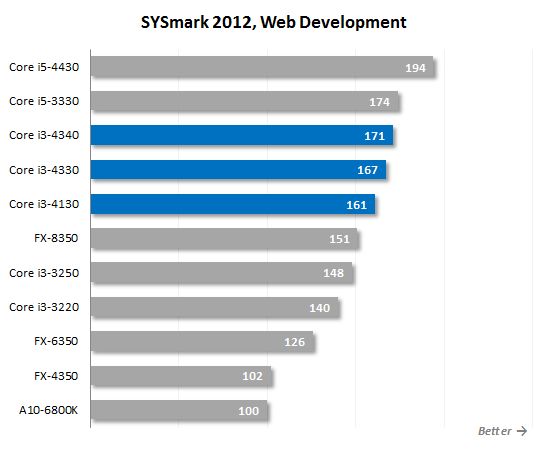
The Data/Financial Analysis scenario is devoted to statistical and market analysis by means of Microsoft Excel 2010.
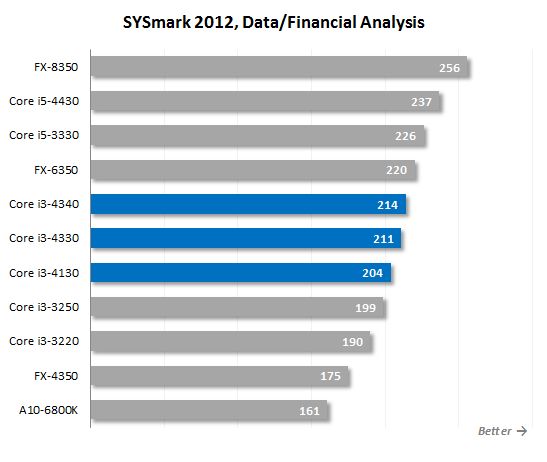
The 3D Modeling scenario is about creating 3D models and rendering static and dynamic scenes using Adobe Photoshop CS5 Extended, Autodesk 3ds Max 2011, Autodesk AutoCAD 2011 and Google SketchUp Pro 8.
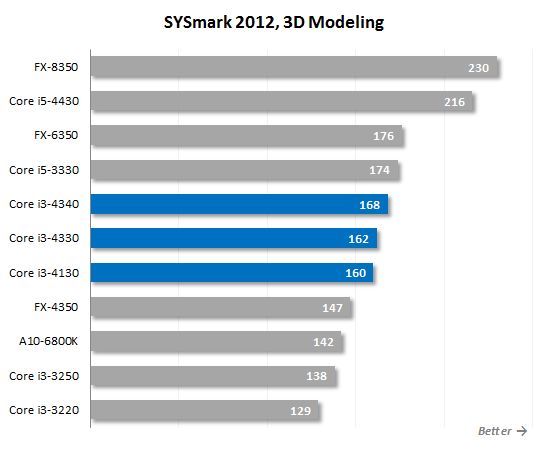
The last scenario, System Management, creates backups and installs software and updates. It involves several different versions of Mozilla Firefox Installer and WinZip Pro 14.5.
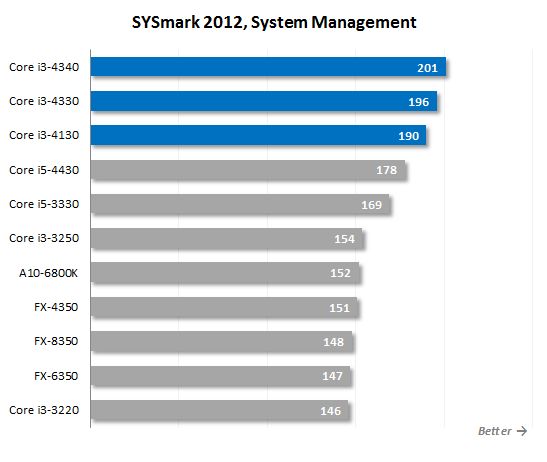
Frankly speaking, the highs and lows of the Haswell-based Core i3 processors were obvious even before the tests. The improvements in their microarchitecture help them perform well as long as there is no multithreaded load. But when the CPU is required to execute several instruction threads concurrently, they are inferior to the Core i5 series (even to the previous Ivy Bridge generation) as well as to AMD’s solutions with more than four cores. Thus, the dual-core Haswell is perfect for office and system applications but cannot compete against the Core i5 at processing financial data, at final rendering and web content authoring.
The transition to the newer microarchitecture hasn’t changed anything in the market positioning of the Core i3 series. They are still an excellent choice for home and office but cannot be recommended for professionals. A dual-core CPU today is an entry-level solution that is far inferior to modern quad-core CPUs in heavy applications.
Now let’s check out the dual-core Haswell-based CPUs in specific applications, starting from games.
Gaming Performance
As you know, it is the graphics subsystem that determines the performance of the entire platform in the majority of contemporary games if the platform has a fast enough processor. Therefore, we select the most CPU-dependent games and measure the frame rate in two test modes. For the first mode we use lower resolutions and disable full-screen antialiasing, so we could see how well the processor can cope with gaming loads in general. This provides some insight into how the tested CPU is going to behave in the nearest future when it is accompanied with faster graphics cards. The second test mode refers to real-life settings: Full HD and maximum FSAA. In our opinion, these results are no less interesting as they demonstrate clearly the level of performance we can expect from contemporary processors today.
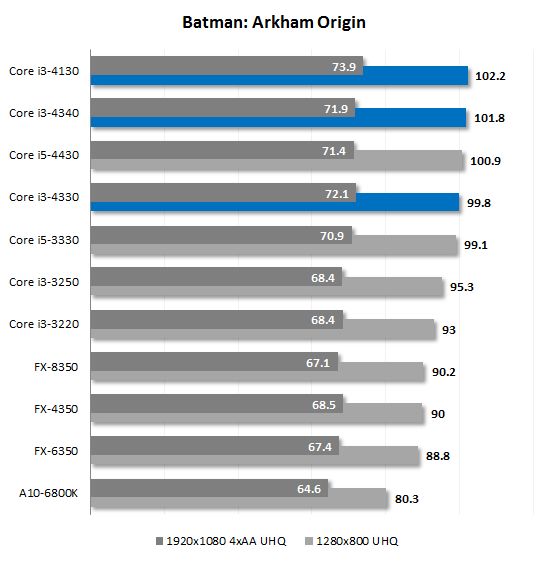
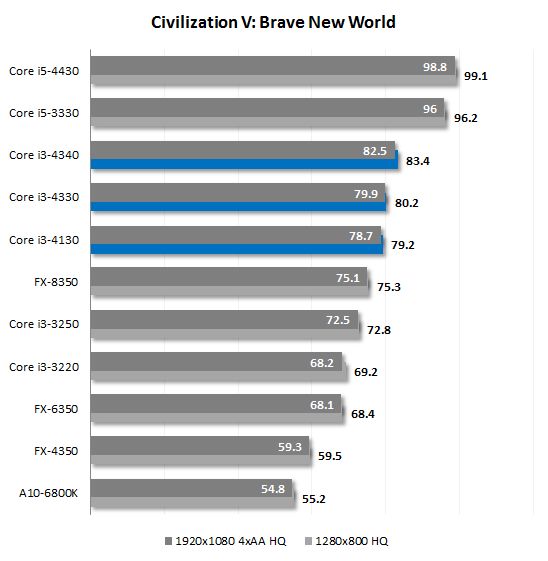
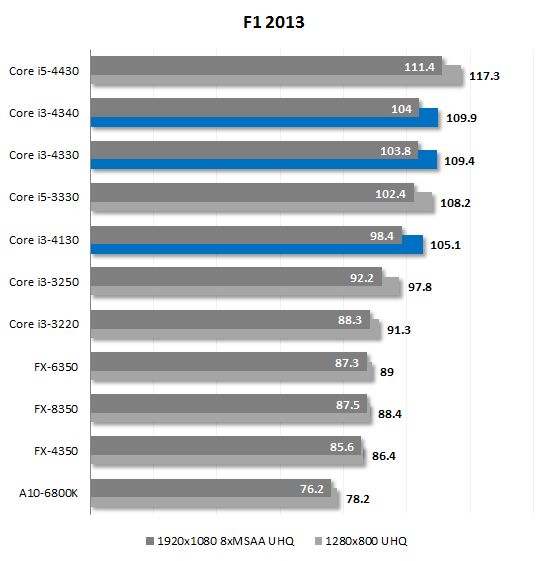
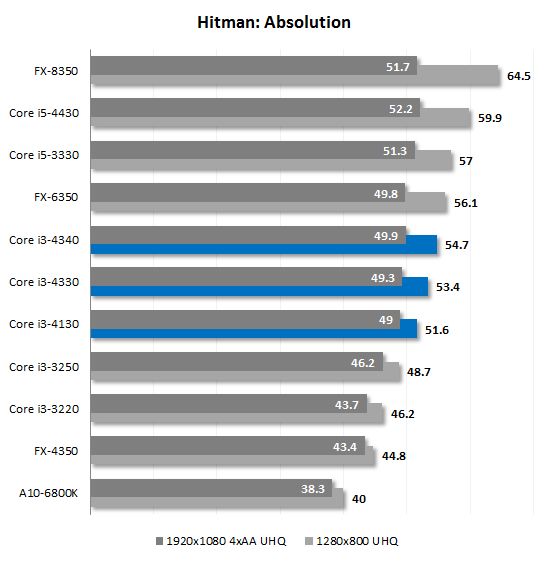
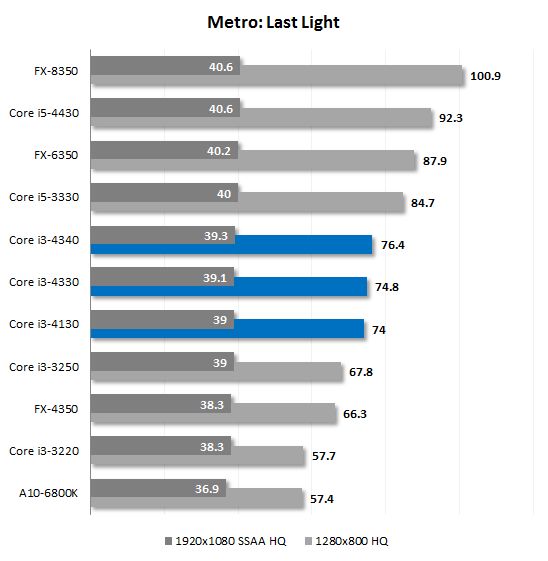
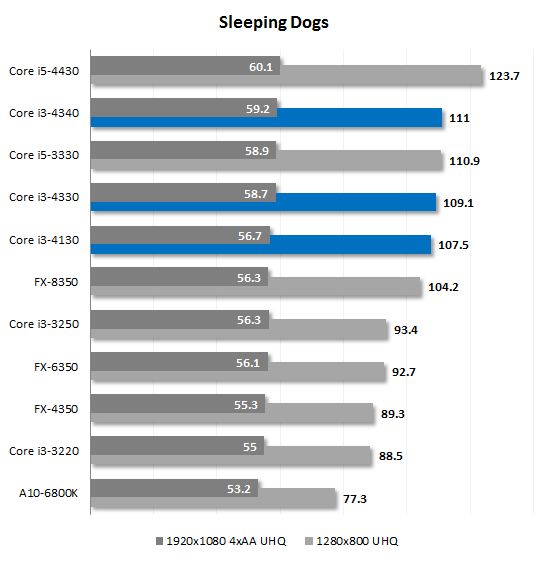
We don’t see a consistent picture in our gaming tests. They fall into two completely different groups. One group are multithreaded applications whereas the other consists of games that can use but two CPU cores at the most. The latter group has been getting smaller recently, yet still includes quite a lot of interesting titles such as Batman: Arkham Origin. The Core i3 series are also not very far behind their quad-core opponents in F1 2013 and Sleeping Dogs, either. These games can use more than two CPU cores but, as the results suggest, Hyper-Threading is quite enough for them. But again, there are games where four CPU cores ensure a much higher performance as you can easily see in the diagrams. That’s why we’d recommend the Core i5 instead of the Core i3 series for building a modern gaming computer.
The Haswell microarchitecture should be given credit for ensuring a gaming performance boost. Any Core i3 4000 series model is easily ahead of any Ivy Bridge Core i3. The larger L3 cache of the senior dual-core Haswell CPUs doesn’t seem to offer big advantages here, though.
We’ll finish our gaming tests by running the popular synthetic benchmark 3DMark.
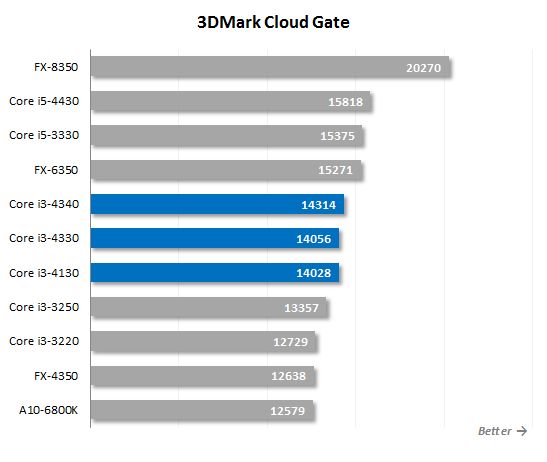
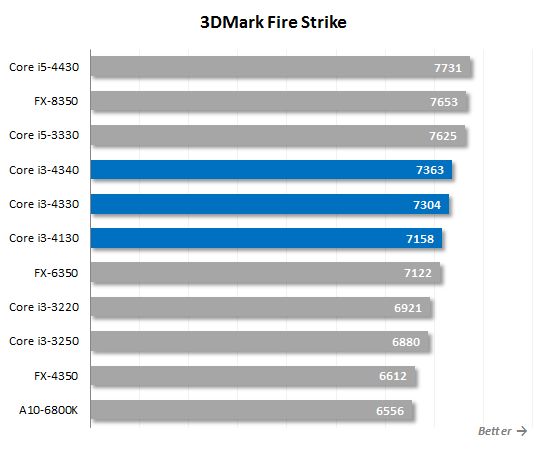
3DMark is optimized for multithreaded CPUs, so the new Core i3 CPUs fall behind the quad-core i5 series as well as the 8-core AMD FX. They are, however, faster than their Core i3 predecessors and AMD’s quad-core products. It must be noted that the Haswell microarchitecture has made Intel’s dual-core CPUs much faster. The senior Haswell-based dual-core model, i3-4340, is 6 to 7% ahead of its Ivy Bridge counterpart i3-3250 even according to 3DMark, which is actually a graphics subsystem benchmark. Moreover, the i3-3250 is beaten by the junior Core i3-4130 model.
Application Tests
We benchmark 3D rendering performance with Cinebench R15. Maxon has recently updated it, so it can now measure the speed of computing platforms in the latest versions of the Cinema 4D animation suite.
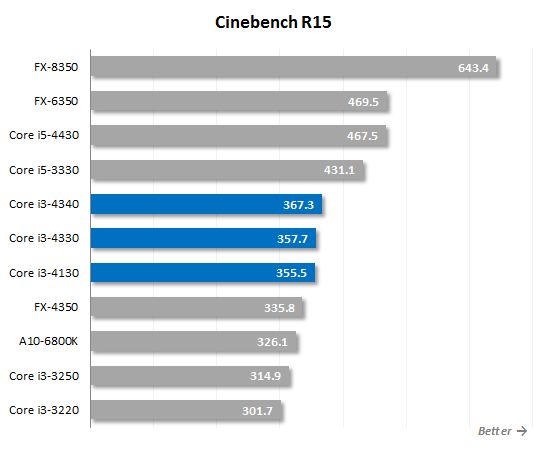
Final rendering is a computations-heavy application which can make full use of the advantages offered by multicore CPUs. That’s why the Core i3 series, even the Haswell-based models, fall behind Intel’s quad-core and AMD’s 6- and 8-core CPUs. The Haswell microarchitecture makes the new Core i3 models faster than their predecessors by about 17%, though.
Using dBpoweramp Music Converter R14.4, we benchmark the speed of converting FLAC files into MP3 format with maximum compression quality.
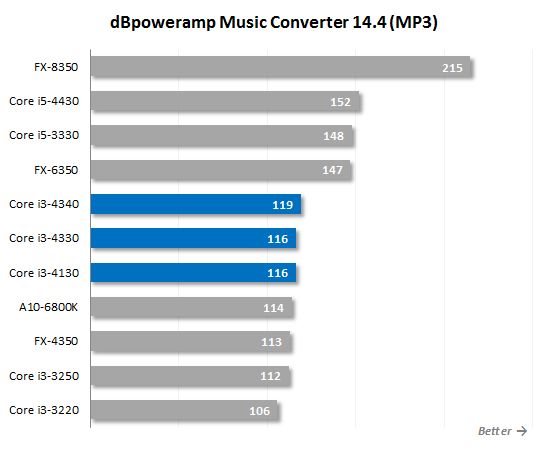
Despite its single-threaded Lame encoder, dBpoweramp Music Converter can transcode several audio files concurrently, making full use of modern multicore CPUs. That’s why we have the same standings as in the final rendering test. The conversion speed is much lower on Intel’s dual-core (and AMD’s quad-core) CPUs than on Intel’s quad-core processors. For example, the gap between the senior Core i3 and the junior Core i5, both having the same microarchitecture, is up to 28%. By the way, the Haswell design is less advantageous in this MP3 encoding test than in the previous benchmarks.
The test scenario for Adobe Photoshop Lightroom 5.2 includes post-processing and exporting into JPEG format of two hundred 12-megapixel RAW images captured with a Nikon D300 camera.
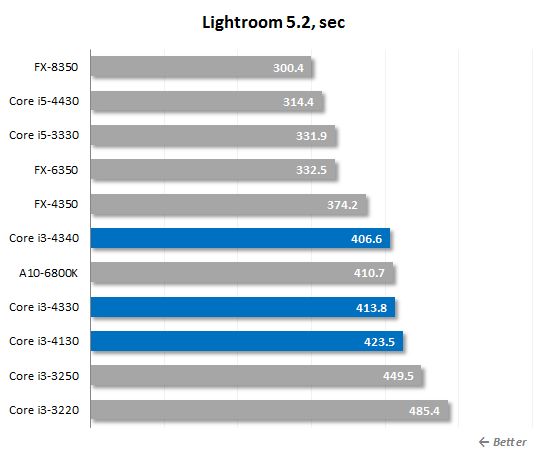
Once again we see that it takes at least a quad-core CPU to efficiently run professional applications. The Haswell microarchitecture works faster in Lightroom than the Ivy Bridge, yet the 10% performance boost is insufficient to make the new Core i3 CPUs comparable even to the older Core i5 of the Ivy Bridge generation. Interestingly, AMD’s quad-core CPUs are also faster than the dual-core Haswell here.
We benchmark CPUs in Adobe Photoshop CC using our custom test that is based on the Retouch Artists Photoshop Speed Test and consists of typical processing of four 24-megapixel images captured with a digital camera.
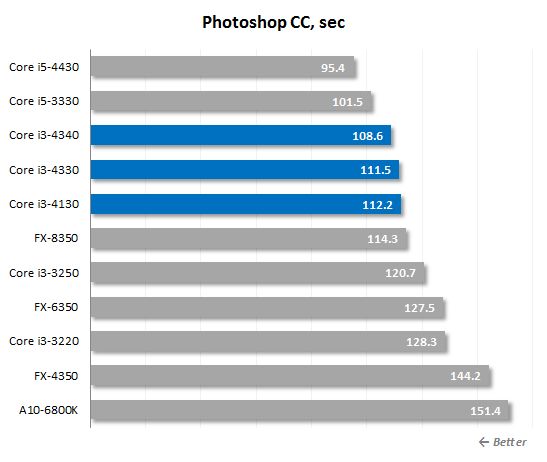
Photoshop has always been well-optimized for Intel CPUs. The new Core i3 models beat the 8-core AMD FX-8350 but lag behind the quad-core i5-3330 of the Ivy Bridge generation. The i3-4340 is 11% faster than its predecessor i3-3250. The Core i3 4000 models have similar results, indicating that the amount of L3 cache isn’t a significant factor. The improvements brought about by the Haswell microarchitecture are far more important.
The processors’ performance in cryptographic tasks is measured with the built-in benchmark of the popular TrueCrypt utility that uses AES-Twofish-Serpent encryption. Besides optimizations for multi-core CPUs, it supports the AES-NI instructions.
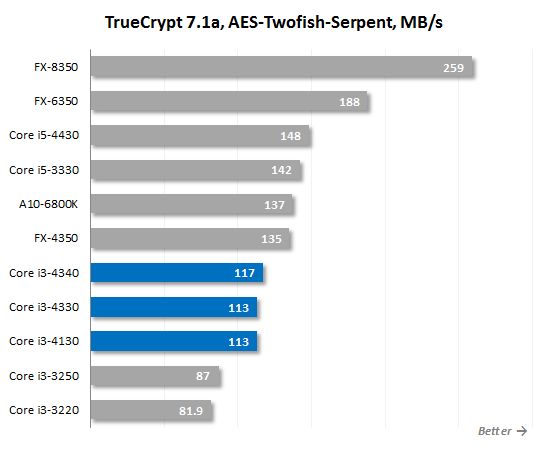
One of the most notable innovations in the new Core i3 CPUs is their support for the AES-NI instructions which ensure substantial performance benefits for encryption algorithms. That’s why the i3-4340 is up to 35% faster than the old i3-3250 here. Still, the quad-core CPUs from both Intel and AMD remain a better choice for this type of applications.
To test the processors’ performance at data archiving we use WinRAR 5.0. Using maximum compression rate, we archive a 1.7GB folder with multiple files.
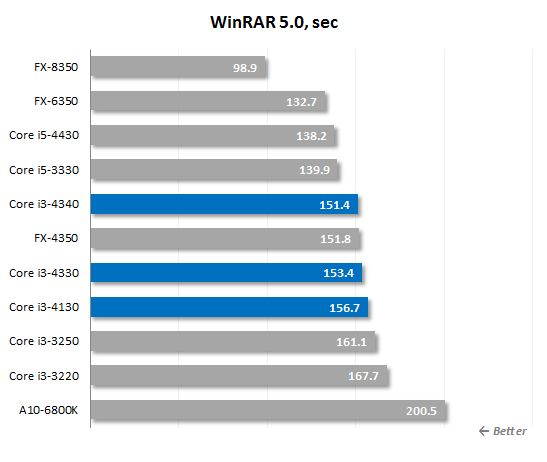
The speed of data compression depends on two factors: computing power (i.e. the number of CPU cores) and system memory performance. So we had expected to see the benefits of the 4MB L3 cache of the senior Core i3 4000 series models here. However, the i3-4340 isn’t much better than the i3-4130. The enlarged L3 cache seems to be a marketing trick rather than a real performance-improving innovation but the new microarchitecture brings improvements of its own. The i3-4340 is 6% ahead of the i3-3250, for example. Of course, the new dual-core CPUs cannot compete with the quad-core i5 models of the Ivy Bridge generation, but perform very well for their price range. AMD’s senior Socket FM2 model A10-6800K is substantially slower even than the junior i3-4140.
In order to measure how fast the tested CPUs can transcode video into H.264 format we used x264 FHD Benchmark 1.0.1 (64 bit). It measures the time it takes the x264 encoder to convert an MPEG-4/AVC video recorded in 1920×1080@50fps format with 30 Mbps bitrate. The results have high practical value, because the x264 codec is part of popular transcoding utilities, such as HandBrake, MeGUI, VirtualDub, etc. We regularly update the encoder used in this performance test. This time around, we use version r2358, which supports all contemporary instruction sets including AVX2.
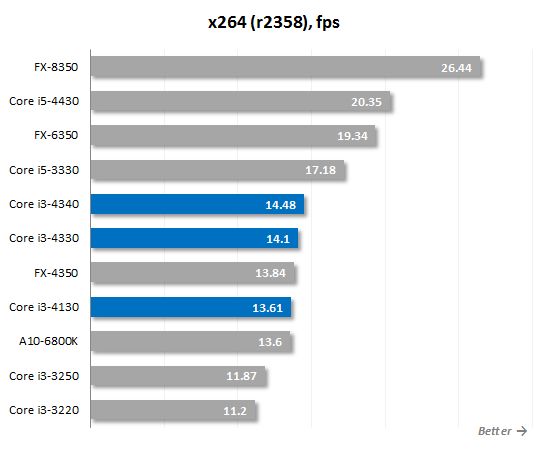
The AVX2 support and the new Haswell microarchitecture raise the performance bar of the Core i3 series by about 22% in this test. The new CPUs can’t match the quad-core i5-3330 and fall behind the quad-core Haswell by over 40%, but now they at least have become as fast as the quad-core CPUs from AMD.
Encoding video with a bare encoder is hardly a real-life application, so we want to check out the speed of video transcoding with the popular free tool Freemake Video Converter 4.0.4. It uses the FFmpeg library and is based on the x264 coder too, but features certain optimizations. We disable CUDA and DXVA for this test to create maximum load on the CPUs’ computing cores.
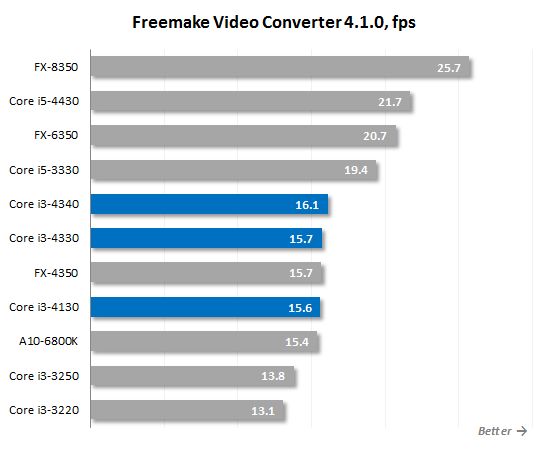
As expected, the speed of encoding in Freemake Video Converter is comparable to the speed in the x264 test above. The new Core i3 4000 series CPUs have similar results. They are faster than their Ivy Bridge predecessors and compete with AMD’s quad-core products. Intel’s quad-core and AMD’s 6- and 8-core CPUs are much faster, though. So again, the Core i3 series is only good for the internet and office applications. It is better to use a CPU with more x86 cores for computers employed for content processing and authoring. And a junior CPU model of that kind wouldn’t be much more expensive than a senior Core i3.
Power Consumption
CPUs of the Core i3 class are often used in low-power computers. Being fast enough for many everyday applications, they don’t require much power and don’t dissipate much heat, so they are perfect for compact HTPCs, for example. The Haswell-based Core i3 products promise an unprecedented performance/watt ratio because, as we’ve seen in our tests, they have become faster but have a lower specified TDP. According to the official specs, their TDP is 54 watts, which is 1 watt lower than specified for the Ivy Bridge Core i3 CPUs.
The Haswell microarchitecture increased the power requirements of Intel’s quad-core CPUs, so we are curious to measure the power consumption of the entire Core i3 4000 series now. The graphs below (unless specified otherwise) show the full power draw of the computer (without the monitor) from the wall socket. It is the total power consumption of all system components. The PSU’s efficiency is taken into account but our Corsair AX760i is a highly efficient 80 PLUS Platinum product, so its effect on the result is very small.
The CPUs are loaded by running the 64-bit version of LinX 0.6.4 utility with support for AVX and FMA instructions. Moreover, we enable Turbo mode and all power-saving technologies to correctly measure the computer’s power draw in idle mode: C1E, C6, Enhanced Intel SpeedStep and AMD Cool’n’Quiet.
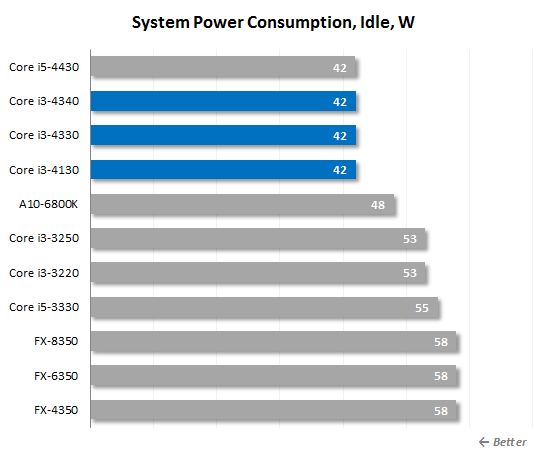
The Haswell microarchitecture is unrivalled among today’s CPU designs when it comes to the power consumption in idle mode. The diagram just proves this point once again. Intel has polished off its power-saving technologies very well.
It must be noted that the GeForce GTX 780 contributes a lot to the total power draw of our test configuration in idle mode. The Haswell would enjoy a larger advantage if we used the integrated graphics cores. The new Core i3 CPUs would require 30 to 35 watts in that case.
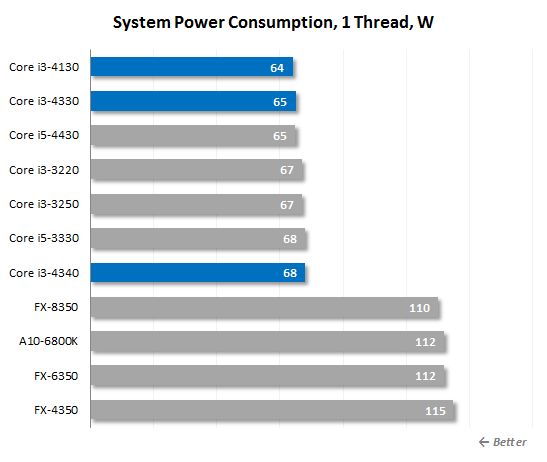
The Haswell-based CPUs are comparable to the Ivy Bridge generation in terms of power consumption at single-threaded loads. That’s good as their power draw remains at a rather low level. For example, AMD’s CPUs need 40 to 45 watts more at such loads.
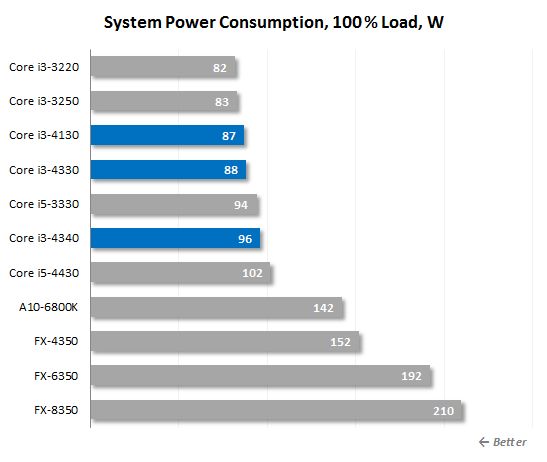
When running the resource-consuming Linx 0.6.4 AVX utility, the AMD CPUs call for a lot of power. Intel’s modern products with comparable performance need only half as much. Although the Haswell-based Core i3 models are theoretically more economical than their dual-core predecessors, they actually consume a few watts more at maximum loads. So, their reduced TDP is not reflected in real-life applications. It is hard to explain why but you should be aware that desktop PCs with Ivy Bridge CPUs are generally a little more economical at peak loads than their Haswell-based counterparts.
The higher power requirements of the Haswell-based Core i3 products would become even more evident if we used the integrated graphics core instead of the discrete graphics card. When there’s high load on the x86 and graphics cores, the i3-4340 will require up to 110 watts whereas a comparable configuration with a dual-core Ivy Bridge, which has a GT2-class graphics core, needs no more than 90 watts. On the other hand, the new Core i3 CPUs are faster in terms of both x86 and graphics cores.
Integrated Graphics Performance
We already discussed the performance of the graphics core available in Haswell-based CPUs in our dedicated review. So today we won’t run too many tests just because the new Core i3 series features the same GT2 graphics as the quad-core CPUs for the LGA1150 platform. There are certain nuances in its implementation, though.
The i3-4340 and i3-4330 have nothing to do with them, though. These CPUs use the Haswell’s standard Intel HD Graphics 4600. It is Intel’s midrange graphics core and also the most advanced one available in desktop LGA1150 CPUs, including 20 execution devices and supporting Quick Sync technology. In the Core i3 series it is clocked at a standard 1150 MHz (the Core i5 and Core i7 clock their integrated graphics core at 1100 to 1250 MHz).
The integrated graphics core of the i3-4130 model is called Intel HD Graphics 4400. It belongs to the same GT2 class but has only 16 instead of 20 execution devices. The clock rate is no different at 1150 MHz. The HD Graphics 4400 works with up to three monitors simultaneously and supports Intel’s Wireless Display and Quick Sync technologies.
It is because of the i3-4130 model with its HD Graphics 4400 that we feel obliged to run a few graphics benchmarks. We’ll compare four CPUs here: a Core i3-4340 with Intel HD Graphics 4600, a Core i3-4130 with Intel HD Graphics 4400, a dual-core Ivy Bridge i3-3225 with HD Graphics 4000, and AMD’s A10-6800K with Radeon HD 8670D.
As a tentative test of the 3D performance of the integrated graphics cores, we will run Futuremark 3DMark. Its Cloud Gate test is designed to benchmark DirectX 10 performance of typical home PCs whereas the most resource-consuming Fire Strike is targeted at gaming DirectX 11-compatible configurations.
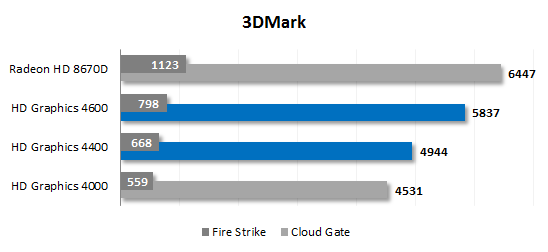
Although the HD Graphics 4000 has the same number of execution devices as the HD Graphics 4400, Intel’s new graphics core works faster due to improvements in the texture-mapping units and in the early stages of the graphics pipeline. The resulting advantage of the HD Graphics 4400 amounts to 10 to 20%. With fewer execution devices, it is, however, slower than the HD Graphics 4600 by about 20%. AMD’s integrated graphics in the A10-6800K is much faster than Intel’s solutions, though.
Now we’ll run four games: a racing sim GRID 2, a 3D shooter Metro: Last Light, and two action games Tomb Raider and Batman: Arkham Origins.
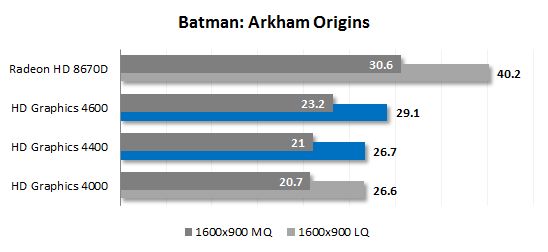
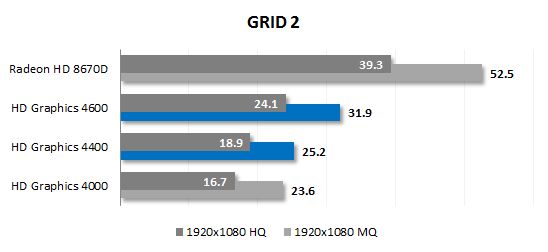
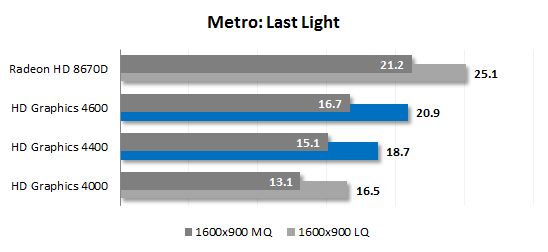
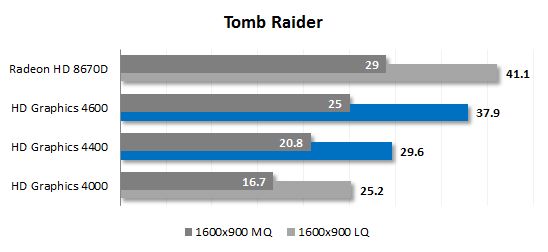
We’ve got the same picture in every game: the HD Graphics 4400 is faster than the Ivy Bridge’s GT2 implementation by an average 12%. Today’s maximum GT2 variant is better yet, ensuring a 20% higher performance. This might be expected since the HD Graphics 4600 incorporates 20% more execution devices. AMD’s integrated graphics is unrivalled, though.
To test the Quick Sync technology implemented in the HD Graphics 4400, we use CyberLink MediaEspresso 6.7 which supports both Intel’s Quick Sync and AMD’s VCE. The test consists of transcoding a 1.5GB 1080p video clip in H.264 format (a 20-minute episode of a popular TV series) into a lower-resolution version for watching on an iPhone 4S. So, the target format was H.264, 1280×768 pixels with a bitrate of about 6 Mbps. We selected the highest transcoding quality.
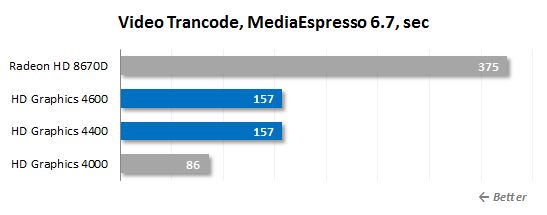
These results suggest that Quick Sync works in exactly the same way on the HD Graphics 4600 and HD Graphics 4400. This is good news because in the Ivy Bridge generation the junior variants of the integrated graphics core had a lower-speed version of Quick Sync. You may be alarmed to see that the Haswell-based CPUs take more time to transcode the video than the Core i3-3225, but there is an explanation. There are just new quality profiles for Quick Sync in the Haswell-based CPUs. Transcoding takes more time but produces a much better result, which is closer to software-based transcoding.
Conclusion
The dual-core i3 4000 series CPUs turn out to be quite ordinary Haswell-based products. Although Intel added an extra megabyte of L3 cache and unlocked additional instruction sets in them, the new Core i3 CPUs don’t behave in any unexpected way. Such fundamental features as the number of x86 cores, clock rates and lack of Turbo Boost have been retained with the transition to the new microarchitecture, so the dual-core Haswell-based products differ from their predecessors just like the quad-core CPUs do. It means that they are 10% faster on average. According to our earlier tests of Haswell-based CPUs, this is a typical performance improvement ensured by the new microarchitecture.
So, you can’t expect anything extraordinary from the new Core i3 series. They are the same-class dual-core processors as they used to be. They can only make an alternative to quad-core CPUs if the latter are AMD. Neither the new microarchitecture nor Hyper-Threading lets them reach the performance level of the Core i5 series (even of the earlier generations). The Core i3 CPUs can only be recommended for midrange computers which are not intended for authoring and processing of HD content. They are no good for enthusiasts, either. They lack any overclocking capabilities.
Although we’re talking about the Core i3 as a kind of compromise solution, this CPU series is actually optimal not only for office machines but also for home PCs. They are fast enough for office applications, for playing multimedia content, and for using the internet. They are also good enough for 3D games, even newest ones. The Core i3 should also be given credit for low power requirements. The Haswell microarchitecture lowers the computer’s power draw to unprecedented levels in idle mode.
Moreover, the Haswell-based Core i3 CPUs can work without a discrete graphics card. Their integrated graphics cores (HD Graphics 4600 and 4400) are sufficient for a wide range of applications and support hardware acceleration of video transcoding, even at 4K resolutions. Although they are not fast enough to run today’s games in Full-HD mode, they are quite suitable for entertainment and multimedia applications.